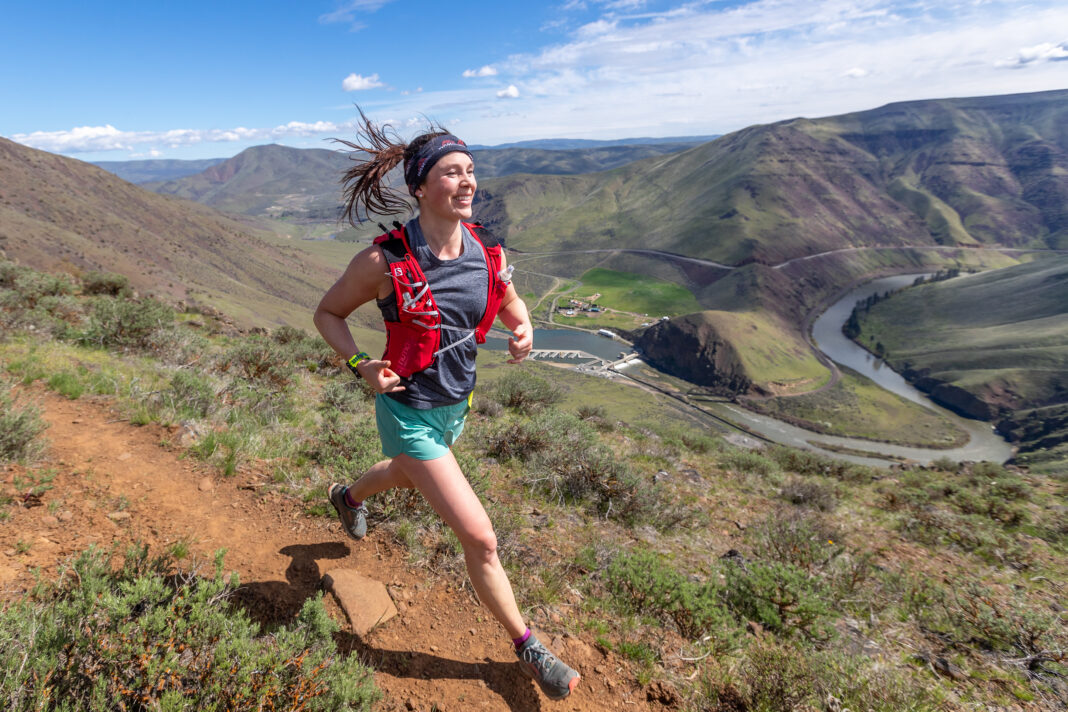The days are longer and the sun is out—peak running weather for those looking to hit the trails for an adventure. There’s no doubt about it: summer is the best season to swap out those carbon-plated roadies and dip your toes into your trail-running sneakers. But lacing up for the trails takes some added preparation to accommodate for safety, readiness, and ultimate fun. Here, your most burning questions answered for not only introducing trail running into your routine, but maintaining it for the long haul.
Q: How do you warm up for a trail run?
A: A warm-up routine doesn’t need to be time consuming, but it should be a part of the trail-running process. The majority of trail-running injuries occur in the lower leg, primarily in the form of sprained ankles. A warm-up routine that includes dynamic flexibility, balance, plyometrics, and neuromotor strength can decrease your risk of injury. Your warm-up will depend on your individual needs and injury background, but see sidebar “Trail Running Warm-up” for a go-to warm-up that addresses the most pressing areas, and gets you prepped for the trails in just seven minutes.
Q: Do I need to eat on my run?
A: Eating is an overlooked and important part of trail running. You are typically out for a longer duration of time and need to account for differences in elevation that can be more calorically costly than running efficiently on flat roads. When you run out of available glycogen, your body will hit the dreaded “bonking” state. This is when you’ll feel your muscles begin to shut down and continuing to run will become very difficult.
Your pre-run meal or snack should be consumed anywhere from two hours to 90 minutes in advance of your run. If you are running for less than 60 minutes, you may not need food or water; however, if you are practicing for a longer distance, it is important that you train with food and water as you want your body to be used to it before the event.
The general rule of thumb is to consume between 150-300 calories per hour and drink 16-24 oz per hour once you are running longer than 60 minutes. The exact amount of food and drink will depend on a variety of factors, including the temperature and how quickly your body processes calories.
Q: What kind of shoes do I wear?
A: This question is highly personalized to the shape of your foot and how you like to run. For a true shoe fit, look for a store that has a treadmill in it, so you can test how the shoes will feel on an incline and at both hiking and running speed.
You should get a shoe based on where you will be running. For example, if you are running on relatively wide, groomed dirt trails, you probably don’t need trail-running shoes with stellar grip and a heavy tread. However, if you are running on rugged mountain bike trails with roots and rock slabs, having a sticky sole with lots of grip would be helpful.
There are wide and narrow styles of trail runners, and some have GORE-TEX, while others promote a quick-dry feature. Chances are, if you are on the trails, your feet will get wet, GORE-TEX or not. Most importantly, pick a shoe that gives you a little extra room as your feet will swell when you run for longer periods of time.
Q: Should I do strength training while I am trying to become a trail runner?
A: Unequivocally, yes. Trail running requires you to be able to pick up your feet over roots and rocks, bound downhill and uphill, and balance speed with agility in natural terrain. Strength training is a key part to both injury prevention and training safely. Incorporating a strength routine two to three times a week is non-negotiable to have longevity and balance in this sport.
For routines that are beneficial for trail running, include heavier compound lifts with lower repetitions. Focusing on range of motion within the movements and adequate rest time in between sets are key features of an effective strength program for endurance athletes. Incorporate plenty of single-leg work. Remember that while you are running more, the gains in the gym will take a back seat—this work should be considered as mostly preventative.
Q: If I’m brand new to running, what would a typical training week look like for me?
A: If you are starting to run, a typical week would look like three to four run days, two strength- or cross-training days, and at least one full rest day. The time or distance that you run will start smaller and progress over time. Finding a running group is one of the best ways to get acquainted with other people who have similar goals. These groups often complete a longer run on the weekends, which fits into a typical training schedule of shorter workouts during the week, and the longer, slower run on a weekend.
Trail Running Warm-Up
Complete 2 sets of 10 reps of each exercise per side:
- Bird-Dog Crunch
- Side-Plank Clamshell
- Skater Hops
- Wall-Assist Single-Leg Hip Hinge
You may also like: Training for Your First 25 km Trail Race

Read This Story in Our 2024 Summer Outdoor & Travel Issue
Featuring Canadian Taekwondo Olympian, Skylar Park. Must-visit adventure destinations across Canada. Your best trail running season ever with FAQs and threshold training plans. How (and why) gravel biking can rule your summer. Essential preparation to stay injury-free during hikes. Zero-waste your hiking and camping trips like a pro. Treat yourself with a Rustic Strawberry Chocolate Tart or Dairy-Free Vanilla Ice Cream, and so much more.

















